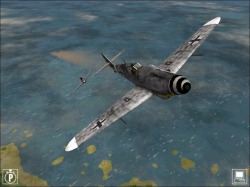| B17 II at ECTS
by Obi Offiah |
||||
|
Flight Models I went over to Dominic and asked him a few questions about the flight models. "We've modelled the aircraft fully," he explained. He told me how it was possible to stall the aircraft in multiple ways. He said it was possible to stall one wing, different parts of the wing at different times, etc. I was most impressed. Dominic displayed how he had tried to perform a negative-G outside loop in an aircraft (possibly the P-51.) He was inverted and had pushed the stick full forward aggressively which caused him to stall. He explained that to perform such a maneuver you have to be gentle and not use as much stick as he had tried. From our earlier interview: "We have engine torque, ground effect, wind, gusts, prop wash, turbulence. Control surface trimming, altitude/pressure/temperature effects. G effects on engines. Propeller/speed/efficiency models, ground effect, compressibility. Fly low over the airfield and dip the wing onto the grass - see what happens! We have belly landings and ditching on water. Lower the gear and feel the drag, feel the nose drop. Raise the flaps and feel the nose drop. Transfer fuel from left to right wingtanks and feel the pull to the right." "We consider the flight models an absolute key issue and we believe we have modelled them to the highest level of detail yet. There are too many factors to list here, but here are a few… Pilots arrive at a "power" rating for their engine by manipulating not a "throttle" but the aircraft's Propeller Speed, Fuel Mixture, Manifold Pressure and Supercharger speeds. That means that the engine itself loses no power as altitude increases, but the supercharger will need to be cranked down because as the air gets thinner the relative pressure inside it will increase - effectively reducing the power output.
 "Then we have the fact that we don't simply slap on a fuel weight for the Mustang. We know where the tanks are, which you've been using and, therefore, whether your aircraft is developing a lean away from the standard centre of gravity. "The above are a sample of the detail we've gone into - just about everything has gone in there, and we've stuck to first principles where possible, rather than artificially fudging "effects" for events. Another good example is control surface damage. If you strip 32% of the skin from our Mustangs Port Aileron it's rate of roll will be properly affected…" I flew the P-51 for a short while and it felt very crisp and responsive. It was silky smooth, you could control it very accurately and perform precise moves. The ground rush down low was sensational. If you can compare the flight model of a jet sim and a prop sim I 'think' that B-17's flight model is probably on par if not better than Flanker 2.0's. Now that's saying something, especially coming from me, an avid jet and Flanker fan. |
 Terrain The terrain graphics engine in B-17 are superb, I'am not going to even try and attempt to compare it to other sims because you can't. The level of depth is absolutely incredible. The approach Wayward have taken makes perfect sense to me. I have always been interested in low level ground attack missions, so I favour non-photographic terrain.
 As Graham explained to me the problems with photo terrain, "it looks good high up but down below it's a blur and affects the sense of speed the player has." With other sims featuring photo terrain, the terrain 'looks' realistic from high up, with B-17 not only does the terrain look realistic from all altitudes, it 'feels' realistic too. I believe this is were B-17 will succeed at all levels, its FEEL. The best comparison I can make to B-17 is of a picture in World Air Power Journal volume 21 summer 1995, the one with the F-15E as the main story. If any of you have this book turn to page 58, you'll see a picture taken from the rear cockpit of the Strike Eagle. The aircraft is barrelling down a valley and you can see the clouds above casting a shadow on the valley floor. In the bottom right of the picture you can see trees and other vegetation casting shadows on the ground, that is the exact effect you see in B-17. I am not saying B-17 was photo-realistic, I'm saying that the 'effects' present in B-17 make it the closest thing to reality you can get, it just feels so right. Let's say you're playing a racing sim or a flight sim when the aircraft in the sim is on the ground. If you select an outside view and see no shadows under the aircraft or car, it just doesn't seem to feel right no matter how detailed they or their surroundings are. This is one of the big differences between B-17 and current/upcoming sims, this is where Wayward have done it right. In the B-17 forum at combatsim.com™ someone wrote about how the terrain in B-17 switched resolutions depending on aircraft altitude. This was true, but in my opinion it wasn't that much of a problem for me. I spoke to Ken and Graham about it and they explained that they had just incorporated the terrain graphics engine into the sim for ECTS and that B-17 was still 'PRE-ALPHA'! Go to Part VI
|
|||
|
Copyright © 1997 - 2000 COMBATSIM.COM, INC. All Rights Reserved. Last Updated September 15th, 1999 |
||||
